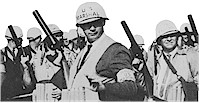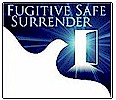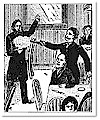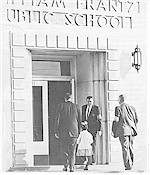| Even after
the creation of more than 50 specialized federal law enforcement
agencies during the 20th century, the Marshals retained the broadest
jurisdiction and authority. For over 200 years now, U.S. Marshals and
their Deputies have served as the instruments of civil authority
used by all three branches of government. Marshals have been
involved in most of the major historical episodes in America's past.

The history of the Marshals is, quite
simply, the story of how the American people govern themselves.
This section of the web site not only
portrays, in words and pictures, the modern Marshals Service, but it also
recounts many of the highlights from the history of the U.S. Marshals; a
span of history that is unique in American law enforcement.
The Marshals
Service looks back on a proud heritage - a tradition spanning two
centuries of service to the Nation and dedication to the principles of
our Constitution and the rule of law.
As our young nation expanded
westward, U.S. Marshals embodied the civilian power of the Federal
Government to bring law and justice to the frontier. For every new
territory, marshals were appointed to impose the law on the untamed
wilderness. And, at virtually every significant point over the years
where Constitutional principles or the force of law have been
challenged, the marshals were there - and they prevailed.
The challenges faced today by
Marshals and their Deputies are no less demanding than those of the
past. In fact, the skills, devotion and determination required to
carry out our contemporary responsibilities make the modern Marshals
Service a unique and elite cadre of law enforcement professionals.
And so, in looking back over our history, we would hope the you
recognize and take pride in the fact that this agency is an intimate
part of the continuum of the grand American experiment in
self-government.
Other historical information:
U.S. Marshals Museum
With the forthcoming United States Marshals
Museum in Fort Smith, Arkansas, there have been many questions as to
what might be included as exhibits. In determining this,
see a
composite of photographs from our previous exhibit, which highlight some
of the artifacts and case work. The place and time of each photograph
varies, but all were taken between late 1988, when the tour began,
through early 2003. Read and See More.General
Identify Yourself! |
U.S. Marshals and their deputies have excelled
for over 200 years, but a common object over time is the identifying
instrument and documentation presented while conducting agency business. |
 |
|
1800's
1900's

Operation FALCON is a nationwide fugitive
apprehension operation coordinated by the United States Marshals
Service (USMS). The resources of federal, state, city and
county law enforcement agencies are combined to locate and
apprehend criminals wanted for crimes of violence.
Operation FALCON represents a continuing series of historically successful national
fugitive apprehension missions, which have resulted in the
collective capture of more than 30,000 dangerous fugitive felons
during three total weeks.
The original FALCON I proved the efficacy of the
cooperative law enforcement model, which seeks to multiply the
positive impact of law enforcement at all jurisdictional levels.
The emphasis centered on gang related crimes, homicides, crimes
involving use of a weapon, crimes against children and the
elderly, crimes involving sexual assaults, organized crime and
drug related fugitives, and other crimes of violence.
FALCON II reaffirmed and built upon the success of the initial
FALCON effort, achieving a comparable level of total arrests,
while covering only one-half the geographic area of the first
nationwide operation. Moreover, FALCON II focused on combating a particular
category of fugitive offender. The results of this innovation
speak for themselves, as FALCON II investigators successfully
removed more than 1,100 dangerous sex offenders from America’s
streets.
FALCON III continued to advance these important efforts, and
focused heavily on the danger posed by fugitive felons who fail
to register as sex offenders, as well as those with gang
affiliations. FALCON III covered the eastern half of the United
States, with 48 federal districts in 24 states participating.
FALCON III resulted in the apprehension of 10,733 fugitive felons, ensuring the
continuing safety of America’s communities.
FALCON 2007 focused on gang
members and gang activity in targeted urban areas. Consistent with the
Department of Justice goals and objectives, the success of these
localized operations resulted in the U.S. Marshals Service
conducting several additional operations targeting various offender groups in
selected States, districts, areas, and cities. The initiatives took place at varying times, and
targeted violent fugitive felons, sexual offenders, and individuals associated with gang activity.
FALCON 2008 - In June
2008, the U.S. Marshals teamed with its partners from federal,
state, and local law enforcement to engage in the record-breaking
Operation FALCON 2008 (Federal And Local Cops Organized Nationally).
This initiative represented the fifth effort in a continuing series
of historically successful national fugitive apprehension missions,
which have resulted in the collective capture of more than 55,800
dangerous fugitive felons.
 Fugitive
Safe Surrender is a unique, creative, and highly successful
initiative that encourages persons wanted for non-violent felony or
misdemeanor crimes to voluntarily surrender to the law in a
faith-based or other neutral setting. Managed by the United States
Marshals Service as a community re-entry program for wanted
non-violent offenders, Fugitive Safe Surrender offers individuals
with felony and misdemeanor warrants the ability to turn themselves
in to law enforcement and have their cases adjudicated in a safe and
non-violent environment. The goal of Fugitive Safe Surrender is to
reduce the risk to law enforcement officers who pursue fugitives, to
the neighborhoods in which they hide, and to the fugitives
themselves. Authorized by Congress in July 2006, Fugitive Safe
Surrender is believed to be the first program of its kind in the
nation. Fugitive
Safe Surrender is a unique, creative, and highly successful
initiative that encourages persons wanted for non-violent felony or
misdemeanor crimes to voluntarily surrender to the law in a
faith-based or other neutral setting. Managed by the United States
Marshals Service as a community re-entry program for wanted
non-violent offenders, Fugitive Safe Surrender offers individuals
with felony and misdemeanor warrants the ability to turn themselves
in to law enforcement and have their cases adjudicated in a safe and
non-violent environment. The goal of Fugitive Safe Surrender is to
reduce the risk to law enforcement officers who pursue fugitives, to
the neighborhoods in which they hide, and to the fugitives
themselves. Authorized by Congress in July 2006, Fugitive Safe
Surrender is believed to be the first program of its kind in the
nation.
Remembrance:
Ronald Van Raalte Recommended Reading —
My Brother J-Boy
By Hilda Hall
Amerikan Press, 2008 (Children’s Biography of James Meredith)
The U.S. Marshals Service
By Connie Colwell Miller
Capstone Press, 2008
(Children's Book)
Henry E. Hudson, Quest for Justice (Loft Press, Incorporated,
September 2007)
Art T. Burton,
Black Gun,
Silver Star:
The Life and Legend of Frontier
Marshal Bass Reeves
(University
of Nebraska Press,
2006)
James H. Chenoweth, Down Darkness Wide: U.S. Marshals and the
Last Frontier (Publish America, 2004)
Rae Anna Victor, George Washington’s
Revolutionary Marshals (Infinity Publishing, 2004)
Charles E. Burrows, Differing Opinions: Memories of a United States
Marshal (1998)
Frederick S. Calhoun, The Lawmen:
United States Marshals and Their Deputies, 1789-1989. Smithsonian
Institution Press, 1989. Penguin, 1991.
Robert Ernst with George Stumpf, Deadly Affrays: Violent Deaths of
the United States Marshals Service 1789-2004. Scarlet Mask
Enterprises, 2006.
|
|
|
1789 |
|
 On September 24, President George Washington appointed the first 13 U.S.
Marshals following the passage of
the first Judiciary
Act. On September 24, President George Washington appointed the first 13 U.S.
Marshals following the passage of
the first Judiciary
Act.
Oldest Federal Law Enforcement Agency |
|
1790 |
|
The U.S. Marshal has been historically assigned the task of conducting
the death sentences on those condemned by federal courts.
|
|
1778-1865 |
|
Until the creation of the Secret Service in 1865,
Marshals were
frequently called upon to pursue counterfeiters. |
|
1790-1870 |
|
U.S. Marshals were required by Congress to take the national census
every ten years. |
|
1794 |
|
 U.S. Marshal Robert Forsyth was murdered while serving civil process on
two Allen brothers. U.S. Marshal Robert Forsyth was murdered while serving civil process on
two Allen brothers. |
|
1794 |
|
August 4 - Supreme Court Justice James
Wilson certified that the Whiskey Rebels were "too powerful to be
suppressed by the powers vested in the Marshal of that district".
Washington called out the state militias.
September 7 - The state militias marched
against the Whiskey Rebels. U.S. Marshal David Lenox rode with
them and marched under the command of President Washington, the only
time in American history a president has taken the field at the head of
his army. |
|
1798 |
|
July 13 - Congress passed the Sedition Act
punishing unlawful combinations against the government or publishing
"false, scandalous, and malicious writing" about the government.
U.S. Marshals and Attorneys enforced the infamous law. |
|
1850-1861 |
|
September 18 - Congress approved the
Fugitive slave Law. U.S. Marshals enforced the Fugitive Slave Act of 1850 by arresting
fugitive slaves and returning them to their southern masters. Marshals
were required to enforce the law. Any negligence in doing so
exposed Marshals and deputies to severe financial penalties. |
|
1857 |
|
Nov. 14 - William Walker launched a military
expedition against Nicaragua. Although arrested by U.S. Marshal
William Wagner (E/LA), Walker posted bail. The expedition failed
in the face of poor weather, poor organization, and British ships. |
|
1861-1864 |
|
|
1860-
1940 |
|
 |
U.S. Marshals Served the
consular courts in China |
|
|
1865-1900 |
|
U.S. Marshals were instrumental in keeping law and order in the "Old
West" era and involved in apprehending desperadoes such as the Dalton
Gang, Bill Doolin, and Ned Christie. See also:
 Line of
duty deaths prevalent in Old West Line of
duty deaths prevalent in Old West
 How much
does it cost to find Billy the Kid? How much
does it cost to find Billy the Kid? |
|
1870 |
|
On July 1, 1870, Congress created the Department
of Justice and gave it supervision over U.S. Marshals and Attorneys. |
|
1872 |
|
U.S.
Marshals, assisted Internal Revenue agents (who had no arrest powers) in
enforcing the whiskey tax laws. |
|
1880 |
|
Prisoner Custody in the 1880's |
|
1881 |
|
Oct. 26 - Tombstone, Arizona - Marshal
Virgil Earp and his deputies, brothers Wyatt and Morgan Earp, and Doctor
John H. Holiday, gunned down Frank and Tom McLaury, and Billy Clanton in
a vacant lot just down the street from the O.K. Corral. |
|
1890 |
|
 Supreme Court held that the President has
power, through the Attorney General, to direct a United States Marshal
to accompany and protect federal judges from a threatened assault:
Judicial Protection: Cunningham vs Neagle 135 U.S. 1 (1890)
; See also
In the
matter of David Neagle, Deputy U.S. Marshal Supreme Court held that the President has
power, through the Attorney General, to direct a United States Marshal
to accompany and protect federal judges from a threatened assault:
Judicial Protection: Cunningham vs Neagle 135 U.S. 1 (1890)
; See also
In the
matter of David Neagle, Deputy U.S. Marshal |
|
1894 |
|
During the Pullman strike, U.S. Marshals were ordered by the federal
courts and the Cleveland administration to keep the trains
rolling.
|
|
1896 |
|
July 1 - The fee system of paying Marshals was
abolished. The Marshals were put on annual salary. |
|
1910 |
|
Nov. 20 - Francisco Madero launched from
U.S. soil his revolution against Mexican President Porfirio Diaz.
The subsequent turmoil in Mexico compelled the U.S. Marshals to
protect the Mexican-American border. |
|
1917 |
|
Marshals and World War I:
While American troops fought in the
trenches of Europe, United States Marshals protected the home front
against enemy aliens, spies, saboteurs, and slackers. |
|
1919 |
|
Oct. 27 - The Volstead Act animated the 18th
Amendment's prohibition on liquor. During Prohibition, U.S.
Marshals arrested bootleggers and seized all of their equipment - cars,
trucks, breweries, and warehouses. |
|
1920 |
|
The 18th Amendment was ratified, prohibiting
the manufacture, sale, and transportation of intoxicating beverages.
U.S. Marshals were the principal
enforcing agents. |
|
1920-1960 |
|
The twentieth century era of specialization left the U.S. Marshals
performing as bailiffs to the courts.
|
|
1937 |
|
Oct. 13 - U.S. Marshals were requested to
run background checks on deputies. |
|
1956 |
|
Dec. 17 - The Executive Office of U.S.
Marshals was created. |
|
1960-1965 |
|
 U.S. Marshals provided security to enforce federal laws and orders to
ensure civil rights. After riots erupted over
James Meredith's enrollment at Ole Miss in 1962, teams of deputies protected him 24 hours
a day for an entire year. In a similar circumstance,
Ruby Bridges was
also provided U.S. Marshals protection when she was one of the first
students to integrate the
New Orleans public schools. See also: U.S. Marshals provided security to enforce federal laws and orders to
ensure civil rights. After riots erupted over
James Meredith's enrollment at Ole Miss in 1962, teams of deputies protected him 24 hours
a day for an entire year. In a similar circumstance,
Ruby Bridges was
also provided U.S. Marshals protection when she was one of the first
students to integrate the
New Orleans public schools. See also:
U.S. Marshals and the Pentagon
Riot of October 21, 1967 |
|
1969 |
|
The U.S. Marshals Service (USMS) was established as a headquarters
organization, overseeing the district U.S. Marshals.
Former agency leaders |
|
1971 |
|
The Witness Security Program was established as a division within the
USMS after the passage of the Organized Crime Control Act of 1970.
The Special Operations Group (SOG) was established to
provide a well trained, self-sufficient, mobile group of Deputies
capable of responding anywhere within the United States and its
territories within a few hours of receiving an activation order. |
|
1973 |
|
Marshals and FBI agents contained the uprising at Wounded Knee, South
Dakota. |
|
1979 |
|
The USMS assumed the responsibility for the apprehension of federal
fugitives. The capture of Christopher Boyce
was the first major fugitive arrested by the Marshals after their
fugitive responsibilities were expanded to include escapees from federal
prison facilities. |
|
1981 |
|
The first of the Fugitive Investigation Strike Team (FIST operations)
was established to operate as a multi-agency taskforce to apprehend
federal, state, and local fugitives. |
|
1982 |
|
The
Closing of the Panama Canal Zone Marshals Service Office
In cooperation with Administrative Office of
the U.S. Courts, established the Court Security
Officer Program. |
|
1984 |
|
Comprehensive Crime Control Act of 1984 |
|
1985 |
|
 U.S. Marshals assumed the responsibility for managing and disposing of
properties seized and forfeited by federal law enforcement agencies and
U.S. Attorneys nationwide. U.S. Marshals assumed the responsibility for managing and disposing of
properties seized and forfeited by federal law enforcement agencies and
U.S. Attorneys nationwide.
 Marshals Service acquired
its first Boeing 727 used for prisoner
transportation. Marshals Service acquired
its first Boeing 727 used for prisoner
transportation. |
|
1989 |
|
 U.S. Marshals celebrated its 200 years of service to the United States. U.S. Marshals celebrated its 200 years of service to the United States.
Official
U.S. Law Enforcement entity in Antarctica |
|
1996 |
|
U.S. Marshals assumed the responsibility for the Justice Prisoner and
Alien Transportation System (JPATS), which merged the air fleets of the
USMS and the Immigration and Naturalization Service (INS)
As a result of the bombings and threats against abortion clinics, U.S.
Marshals were responsible for protecting the clinics and doctors. |
|
1997 |
|
U.S. Marshals provided security for the Timothy McVeigh and Terry
Nichols trials, convicted of bombing the Alfred P.
Murrah Federal Building in Oklahoma City. |
|
1998 |
|
U.S. Marshals established a foreign
investigative presence in the U.S. Embassy, Mexico City, Mexico. |
|
1999 |
|
USMS signed a Memorandum of Understanding with the U.S. Customs, giving
the USMS responsibility to investigate the
majority of their fugitive warrants. |
|
2005 |
|
 U.S.
Marshals completed the largest fugitive apprehension operation in
American history. Through Operation
FALCON (“Federal And Local Cops Organized Nationally”), which was
conducted April 4–10, 2005, Deputy U.S. Marshals and their law
enforcement partners arrested a total of 10,340 fugitives and cleared
more than 13,800 felony warrants. U.S.
Marshals completed the largest fugitive apprehension operation in
American history. Through Operation
FALCON (“Federal And Local Cops Organized Nationally”), which was
conducted April 4–10, 2005, Deputy U.S. Marshals and their law
enforcement partners arrested a total of 10,340 fugitives and cleared
more than 13,800 felony warrants. |
|
2006
|
|

Operation FALCON II April 17- 23, 2006
- U.S. Marshals coordinated with federal, state, city and
county law enforcement agencies in a massive fugitive
dragnet. Read More

Operation FALCON III - Federal and Local Cops Organized
Nationally - A massive fugitive operation took place the week
of October 22- 28, 2006 and covered the eastern half of the United States. As a cooperative effort, Operation FALCON III
removed some of the country’s most dangerous sex offenders and
gang members from the streets, making America’s communities
safer. |
|
2006 |
|
 Fugitive Safe Surrender
was authorized by Congress in July 2006,
Fugitive Safe Surrender is believed to be the first program of its
kind in the nation. a unique,
creative, and highly successful initiative that encourages persons
wanted for non-violent felony or misdemeanor crimes
to voluntarily surrender to the law in a faith-based or other neutral
setting. Fugitive Safe Surrender
was authorized by Congress in July 2006,
Fugitive Safe Surrender is believed to be the first program of its
kind in the nation. a unique,
creative, and highly successful initiative that encourages persons
wanted for non-violent felony or misdemeanor crimes
to voluntarily surrender to the law in a faith-based or other neutral
setting. |
|
2007 |
|
|
 |
America's Star in Space Again!
Read More
06-20-07
|
|

FALCON 2007 focused on gang
members and gang activity in targeted urban areas. |
|
2008 |
|
FALCON
2008 - In June 2008, the U.S.
Marshals teamed with its partners from federal, state, and local law
enforcement to engage in the record-breaking Operation FALCON 2008
(Federal And Local Cops Organized Nationally). This initiative
represented the fifth effort in a continuing series of historically
successful national fugitive apprehension missions, which have resulted
in the collective capture of more than 55,800 dangerous fugitive
felons.
A Visit to Chief
Deputy U.S. Marshal Helen Crawford, Retired - At age 100, Helen
Crawford still prides her long career with the U.S. Marshals. On July
14, 2008, from the sitting room at an assisted living facility, Bonner
Place in Jacksonville, Texas, she related the most exciting of times. |

|

